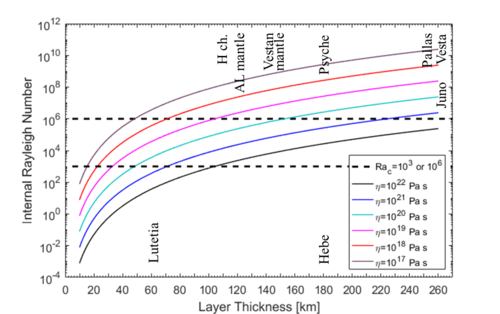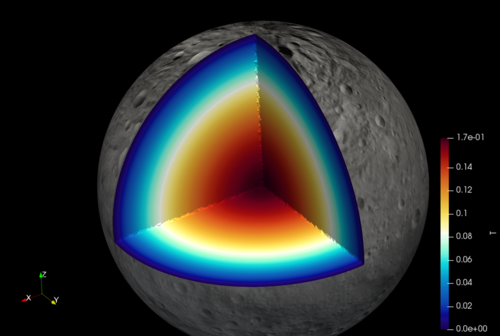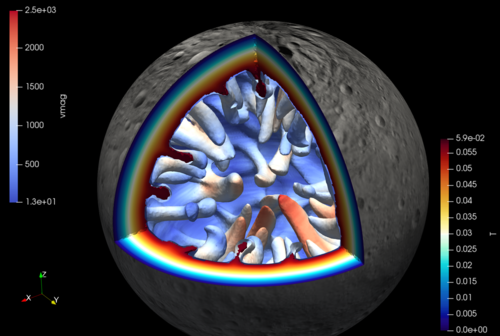1. Introduction
The surfaces of the airless solid bodies of the solar system are exposed to the action of the space weathering (i.e., solar wind, cosmic ray and solar flare, and micrometeoroid bombardment) [1].
Solar wind causes the formation of layered rims up a few tens of nanometres [2]. Cosmic rays of solar flares produce tracks up to some millimetres depth in the regolith [3]. The effects of the bombardment by micrometeoroids range from the melting and vaporization to shock deformation of the regolith’s grains, causing their fragmentation or the formation of pit-shaped microcraters [1].
Enstatite is the second most abundant silicate mineral on asteroid surfaces. Its shock deformation features were reported in numerous meteorites [4]. However, there are no natural reports on the effects of micrometeoroid bombardment. To reproduce such effects, gem-quality oriented enstatite crystals were irradiated by femtosecond pulsed laser [5]. A strong control of the shock direction and a rare occurrence of (100) clinoenstatite lamellae compared to shocked meteorites have been demonstrated [5].
Aimed to study the effects of micrometeoroid bombardment on enstatite, four enstatite-rich Itokawa grains allocated from JAXA have been investigated. Micrometeoroid impacts occur stochastically and unfortunately, none of the four requested grains showed microcraters. Despite that, the samples were sliced by focused ion beam (FIB) and then studied by analytical transmission electron microscopy (TEM).
Here, we report on the microstructures of these grains and discuss them in terms of parent body and space weathering history.
2. Samples
RA-QD02-0205 (#205). It is a prismatic grain (55x43x15 µm3). It is constituted by a single crystal of enstatite (En74.2±3.0Fs24.5±3.0Wo1.7±0.8) that is pervasively crossed by (100) clinoenstatite lamellae. Such lamellae are decorated by dislocations. The grain shows a discontinuous solar wind damaged polynanocrystalline rim (up to 50 nm). The density of solar flare tracks (SFT) is <107 tracks/cm2.
RB-QD04-0092 (#092). It is a flat grain (26x29x12 µm3) consisting of olivine (Fo71-78) and enstatite (En77.9±1.4Fs21.1±1.9Wo1.1±0.5). Olivine shows three localized [001] dislocation-rich areas. Enstatite shows pervasive (100) clinoenstatite lamellae that are decorated by dislocations in three distinct areas. One of these areas is spatially related to the dislocation-rich area in olivine. The grain shows a continuous solar wind damaged rim (40-70 nm). SFT have been found in both minerals and their density is in average 9.6x108 tracks/cm2.
RB-CV-0192 (#192). It is a trapezoid prism (base width 19x8 µm2; height 10 µm). Its volume is mainly occupied by enstatite (En76.3±2.7Fs23.0±2.8Wo1.0±0.4) and diopside (En49.7±2.8Fs7.5±1.2Wo43.1±3.5). Adjacent to them, olivine, plagioclase, and a Ca-phosphate were also detected. Except for the enstatite, none of the minerals shows microstructures. Enstatite is pervasively crossed by (100) clinoenstatite lamellae. The solar wind damaged polynanocrystalline rim varies from absent to 50 nm. The density of the SFT is <3x108 tracks/cm2.
RB-CV-0144 (#144). It is the smallest sample (17x12x5 µm3). It is characterized by a smooth and a rough side. Enstatite (En78.9±3.0Fs20.5±3.4Wo1.1±1.1) and diopside (En50.4±2.8Fs5.7±2.4Wo43.9±3.7) constitute #144. Both minerals are pervasively crossed by (100) lamellae. Among the (100) lamellae in enstatite possible Guinier-Preston zones have been identified [6]. Subgrains and misoriented portions are common in enstatite and diopside. The smooth side is rimmed by a solar wind damaged polynanocrystalline and layered rim (up to 60 nm); on the rough side such rim is absent. The SFT density is ~1.4x108 tracks/cm2.
3. Discussion
Due to the similar chemical composition and mineralogy, the four studied grains likely formed in the same parent body, namely an equilibrated LL ordinary chondrite.
The four grains share the occurrence of (100) clinoenstatite lamellae in enstatite. Despite that, they are texturally different. The (100) is the weakest slip plane of orthopyroxene; hence, such lamellae can form in different geological contexts. The ongoing TEM study aims to resolve the origin of the different lamellar textures and to discuss them in terms of parent body evolution and impact processing.
Before and/or after their fragmentation to the present form, the grains resided at or close to Itokawa’s surface for ~102 to 104 yr as estimated from the SFT densities [3]. The direct exposure on the asteroid surface based on the thickness of the solar wind damaged rims (<70 nm) was <3x103 yr [7]. Rough grain surfaces and absent rims can be indicative of a recent break-up of the samples.
Being exposed on the asteroid surface, regolith grains are also exposed to the impact of micrometeoroids (primary and/or secondary) [8,9]. None of the studied grains shows microcraters, however, localized deformation features ascribable to micrometeoroid impacts were found in #092, i.e., localized [001] dislocations in olivine and dislocations in potential glide configuration associated with the pervasive clinoenstatite lamellae. A similar superposition of microstructures was observed beneath a secondary microcrater in a diopside-rich Itokawa grain [8]. A better understanding of superposed pyroxene microstructures in Itokawa particles and meteorites may provide natural evidence of micrometeoroid bombardment of enstatite. This could become an important part of assessing the recent regolith history of Itokawa and the targets of ongoing and future sample return missions.
Acknowledgements
The authors are grateful to JAXA for providing the Hayabusa samples. Financial support was provided by the DFG and FSU Jena (LA 830/14-1 to FL.; FA 1599/1-1 to AF; DRM/2016-01 to DH).
References
[1] Bennett, C.J., et al. (2013). Chemical Reviews 113:9086-9150. DOI: 10.1021/cr400153k.
[2] Harries, D., et al. (2018). EPSC 2018 Abstract #368.
[3] Berger, E.L. and L.P. Keller (2015). 46th LPSC Abstract #1543.
[4] Leroux, H. (2001). European Journal of Mineralogy 13:253-272. DOI: 10.1127/0935-1221/01/0013-0253.
[5] Schmidt, D., et al. (2019). Geochemistry 79:125542. DOI: 10.1016/j.chemer.2019.125542.
[6] Nord, G. L. (1980). Physics and Chemistry of Minerals 6:109-128. DOI: 10.1007/Bf00311049.
[7] Christoffersen, R. and L.P. Keller (2015). 46th LPSC Abstract #2084.
[8] Harries, D., et al. (2016). Earth and Planetary Science Letters 450:337-345. DOI: 10.1016/j.epsl.2016.06.033.
[9] Matsumoto, T., et al. (2018). Icarus 303:22-33. DOI: 10.1016/j.icarus.2017.12.017.




